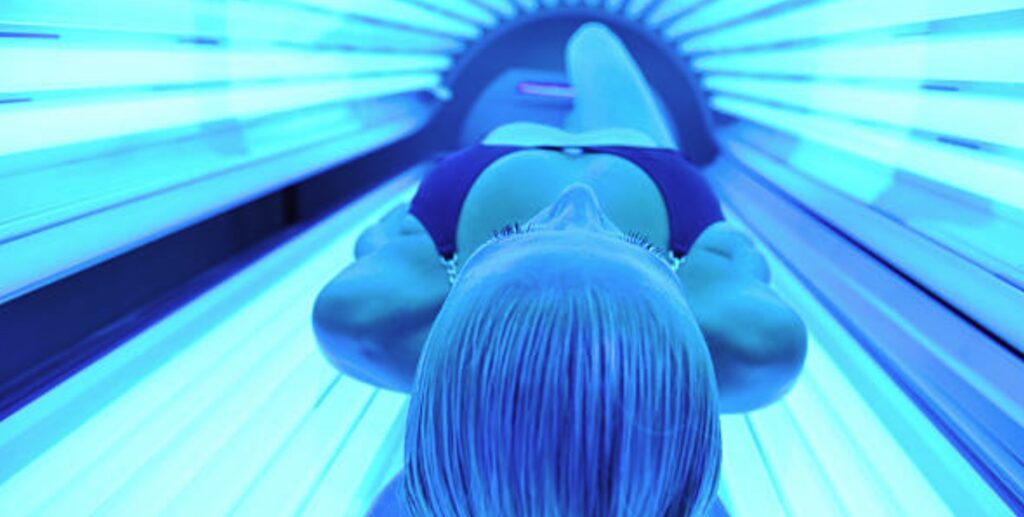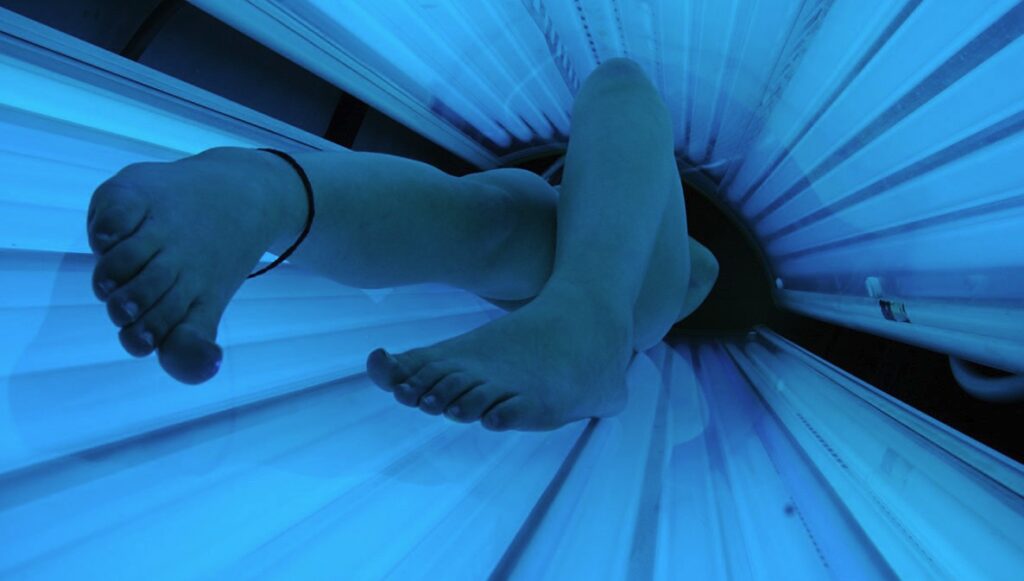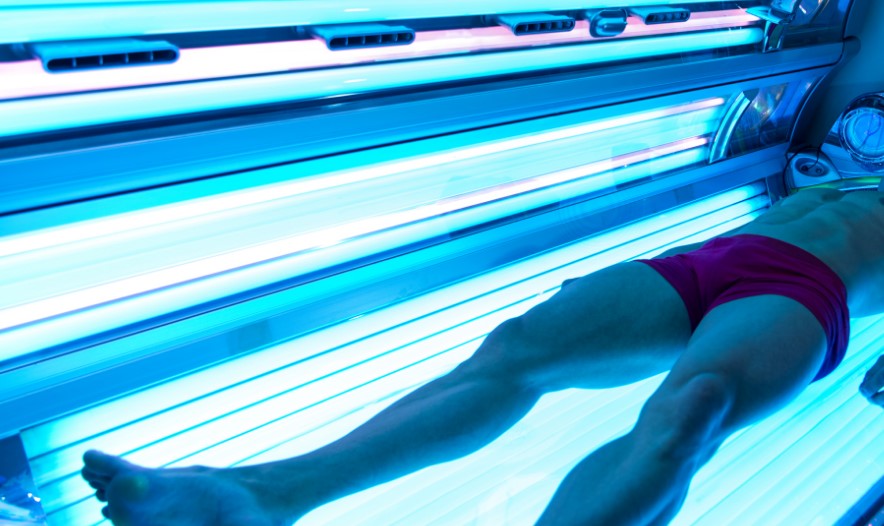Last updated on September 28th, 2023 at 10:26 am
The love for the sun-kissed glow is never-ending thanks to indoor tanning technologies. Safe and limited sunbed tanning causes vitamin D production, improved mood, hormonal balance, and also alleviates skin conditions like acne and psoriasis.
UV induced tans also offer a sun protection factor (SPF) of 3–4 protecting the skin from sunburns. However, exposure to UV rays still poses the risk of developing cancers, premature aging, and wrinkles; therefore, be careful when indoor tanning.
In this article, we have assembled all the tanning bed tips you may need for a beginner.
How do tanning beds work?
Tanning beds, also known as sunbed or solarium, are machines that use ultraviolet(UV) radiation produced by fluorescent tubes or bulbs to give the skin an artificial tan just like UV rays from the sun. These rays stimulate the production of melanin, the brown pigment in your skin.
A regular sunbed has 10-26 bulbs equally divided between the canopy and bench. The more common tanning beds produce about 95% UVA, penetrating deeper into your skin and 5% UVB, similar to natural sunlight. Since UVB rays may be carcinogenic, some newer models produce UVA only while others come with filters that prevent UVB rays from reaching your skin.

On average, 10 minutes in a tanning bed has the same effect as about two hours basking under the Mediterranean summer sun.
Check this too: How Much Does a Tanning Bed Cost?
How to use a tanning bed safely
The following are tanning bed safety guidelines for protecting your body from harmful ultraviolet radiation, causing skin cancer, premature skin aging, and other skin and health problems.
-
Be of appropriate age to use a tanning bed.
Anyone below the age of 16 years should not use a tanning bed or booth. Children and teenagers are more vulnerable to skin damage from sunbed tanning.
-
Make a consultation with a physician before using a sunbed
Even before opting for a tanning bed, it’s a prerequisite to seeking consultation on
- A safe tanning procedure for your skin type; this can also be done at the tanning salon by a professional by filling out a skin type survey.
- Check for any skin conditions like rashes. The UV rays can aggravate your skin condition.
- Also, confirm on any medication you’re on because some medication makes the skin sensitive to sunburns.
The consultation’s benefit is to help familiarize with the tanning process and take the necessary precautions to ensure safe tanning.
-
Use a reputable and licensed tanning salon
Ensure the tanning salon of your choice has well-skilled professionals. They should know tanning procedures, safety, and risks with tanning and the use of equipment.
Talk to the staff about your tanning goals to customize your first and consequent tanning visits to achieve your desired tan. You should expect a skin test to determine your vulnerability to the radiation and pressure.
Check to see if they have safety posters and labels. As a beginner, remember always to ask the staff to go over the tanning process with you. Ensure you know all the functions of the buttons before entering the sunbed.`
-
Prep your skin appropriately
Safe tanning is determined by proper skincare before and after tanning such as;
- Exfoliating and moisturizing your skin to create a good base for UV ray penetration.
- Apply lip balm with SPF 15 to prevent drying and chapping.
- Avoid last-minute waxing and shaving before your tanning or wax and shave 12 or more hours before tanning.
- Apply an indoor tanning lotion an hour before tanning. It improves the tanning process and reduces your tanning appointments’ frequency to achieve your desired result. Indoor tanning lotions determine how much UV rays reach your skin, protecting your skin from sunburns.
Outdoor tanning lotions are ineffective in sunbed tanning.
-
Maintain hygiene
Ensure that the tanning salon maintains high hygiene standards for tanning beds, towels, and overall salon hygiene. Ensure that the staff has disinfected all contact surfaces in between uses. A thorough cleaning can reduce skin infections, which can pass from one user to another.
-
Read safety and warning labels
Carefully read all precautionary labels before using any tanning bed, since every tanning salon has different tanning beds.
These labels have information on exposure time for different skin types and turning time while in the sunbed or even how often you should tan.
Do not exceed the maximum exposure time per day as you risk burning your skin.
-
Choose an appropriate tanning bed
Tanning beds vary in power and intensity. Skin types are from type 1 to type 6, with skin type 1 being the lightest and type 6 being the darkest.
A good tanning salon should have six tanning beds, which come in level 1 to level 6. Level 1 and level 2 are low-pressure sunbeds, level 3 and level 4 are medium pressure beds, while level 5 and level 6 are high-pressure beds.
Low-pressure sunbeds are best suited for beginners, people who rarely tan, and don’t need much tanning( skin type 4 and 5).
For beginners, you should avoid using the high-pressure tanning bed. If you’re not readily familiar with the process, you can easily wind up with tan lines or burns.
-
Eye protection
You must wear sport protective eyewear for eye protection while in the tanning bed, to protect your inner eye from UV damage. The UV rays can damage your retina and cornea and cause cataracts, which can lead to blindness.
-
Tanning duration
The tanning professional will help you decide on the appropriate tanning time depending on your skin type and how often you tan. You can start with 8-10 minutes for the first time and slowly work your way to 25 minutes. Avoid going for a longer duration in one tanning session and risk over-tanning.
-
Avoid applying fragrant skin and beauty products before your appointment
The UV rays can react with the chemicals in skin products and cause skin irritation or prevent proper tanning.
Before getting into a tanning bed, avoid applying any perfume, make-up, or deodorant and wait 24 hours after tanning to resume your beauty products. You can still get some skin irritation when the tan is developing.
How to properly lay in a tanning bed?
Proper positioning in the sunbed allows for even tanning and prevents skin and eye damage from overexposure.
Lay on your back with your arms and legs spread. Ensure there is space between your arms and sides and between your thighs.
Raise your legs slightly and bend your knees to stretch the skin on your thighs and butt. It prevents white streaking over the creases on your butt and upper thigh.

On the half-mark, turn on your belly and raise your arms above your head. We also advise you to stretch occasionally, allowing the skin to make room for more UV exposure.
How to get the best tan in a tanning bed
- Remove any make-up, jewelry and avoid wearing any fragrant beauty products before and 24 hrs after sunbed tanning.
- Shower and exfoliate the night before tanning to remove dead skin cells for better tanning.
- Use a light moisturizer after showering so that the skin can take the tan well.
- Apply a lip balm with SPF protection to block the rays from drying your lips.
- Apply tanning accelerators formulated for sunbed tanning, such as indoor tanning lotions, bronzers, and intensifiers before and after tanning.
- A tanning bed with more bulbs may not guarantee fast tanning, but they will offer an even tan.
- It’s crucial to lay correctly, stretch and occasionally turn for an even tan.
- Always wear protective goggles to protect your eyes from damage by the UV rays.
- Do not stay longer than the recommended time for your skin type; otherwise, you risk burning your skin.
- After tanning, wait for 2-4 hours before showering to allow the indoor tanning lotion to set.
- Apply a tan extender with a moisturizer to rehydrate your skin, helping your tan last longer.
What to wear in a tanning bed
Your reason for tanning determines what you should wear in a tanning bed, but both men and women must wear eye-protective goggles at all times.
Women
You can wear a two-piece bikini. Choose a strapless bra or use nipple covers to minimize bikini tan lines.
Men
You can wear briefs or boxer briefs. You can go nude and cover your privates using a washcloth for a full-body tan as they are more sensitive to heat.
To avoid bikini tan lines when tanning; go nude. Maintain high sanitary conditions on the sunbed. Some salons offer a transparent polythene paper to lie on.
However, the skin on the nipples and private areas are highly sensitive and may be wise to have on nipple covers and underwear.
Alternatively, you can wear tan-through swimsuits designed to allow UV rays through the fabric.
How long should I wait to shower after sunbed tanning?
Showering cannot wash off a sunbed tan; therefore, you can shower immediately after your tanning. However, if you used an indoor tanning lotion, the waiting time is usually between 2-4 hours. But always confirm on the bottle of the indoor tanning lotion you used.
How to get tan fast in a tanning bed
- Exfoliate your skin and shave on the night before your tanning session to remove dead skin for faster UV rays absorption.
- Use quality tan accelerator with moisturizing properties before and after tanning. Having supple skin will allow the rays to penetrate faster. Moisturizing after sunbed tanning increases cell repair and turn-over and gives a long-lasting tan.
- Use a tanning bed with more bulbs, which will tan you evenly faster.
- Quality tanning lamps or bulbs are vital in having the best and quickest tan. You can always ask the staff for the newest set of bulbs which has the most useful life. Useful life is the amount of time a bulb has to produce 70% or more of the rays expected.
- Spread your legs and arms in the sunbed and occasionally turn to tan evenly in less time.
- Frequent tanning sessions will help you reach your maintenance tan quickly. Have a minimum of 48 hours between tanning sessions
- Choose a high-pressure tanning bed meant for fast tanning.
How often should you use a tanning bed?
Depending on your skin type, it takes, on average, 3-5 sessions to develop a tan maintained with regular sunbed use. If you have fairer skin types, you’ll require 4-6 times every once or twice a week, depending on your tanning goal.
You may need 2-4 sessions every once or twice a week for good results for medium skin types. Always wait for 48-72 hours between tanning for your skin to regenerate and the tan to set.
Check this too: How to Stop Itching from Tanning Bed
How to tan your legs in a tanning bed
Your legs tan slower than the rest of your body because the skin there produces less melanin and is drier. To tan your legs in a tanning bed, you need to:
- Always exfoliate using an organic scrub the night before your sunbed tanning.
- Shave and wax your legs at least 12 hours before your tanning to avoid open pores or removing the top layers of your dark skin inhibiting proper tanning, and three days after tanning to allow the tan to develop.
- Apply tan accelerators before tanning for better and long-lasting results.
- When in the sunbed, spread your legs apart and occasionally flip them to the sides for an even tan.
- Apply SPF 50 lotion on your upper body only and expose your legs in the sunbed for a darker tan.
- Moisturize often with a non-clogging lotion before and after tanning and hydrate your skin by drinking plenty of water. Moisturized and hydrated skin will assist in easier absorption of the UV rays and intensifies melanin production.
How Many times do I need to use a tanning bed to get a tan?
For fairer skin types, you may notice a tan after your third session. Your skin type and tanning goals dictate how many tanning sessions you get to achieve your desired tan. The fairer you are, the more tanning sessions you may need for a bronzer look.
But as a beginner, start slowly and increase your tanning time as you build your tan. Once you acquire your desired tan, you can use a sunbed once a week for maintenance.
How long does a tanning bed burn last?
Tanning bed burns are similar to sunburns caused by overexposure to UV radiation in the sunbed. Sunbed burn symptoms are redness, rashes, sensitivity to temperature, soreness, peeling, and blisters.
Mild sunbed burns go away on their own without treatment, but some may require help with quicker recovery. Like a regular burn, the immediate action should be bringing the temperature down.
Remedies
- Apply cold water to cool down the skin. If it’s a small patch, run some cold water over the area for some time. If it’s a large area, stand in the shower and allow the cold water in low pressure to run down the burned area or the whole body.
- Gently apply sunburn cream or Aloe Vera on the area several times a day to soothe and reduce inflammation.
- Keep your body hydrated by drinking lots of water to help with skin turn-over and speed up healing.
- If you still feel pain after the cold shower, you may take mild painkillers.
- Seek immediate medical treatment for severe burns such are blisters and extreme pain or develop a fever.
How to Avoid Tanning Bed Burns
Ideally, it would help if you took precautions to avoid treating tanning bed burns. Below are the precautionary tips to follow:
- Do your research on sunbed tanning. Ask friends and family, use the internet, and consult with your physician to know the tanning procedure for your skin type, risks involved, and precautions to make.
- Get your tanning done reputable and licensed salon which has qualified staff. It reduces the risk of complications such as burning.
- Do a tanning skin test before going into a sunbed to determine your skin’s sensitivity to the radiation.
- Do not stay in the tanning bed longer than the recommended duration or use a tanning bed with low intensity. Do shorter periods in the first week as the skin is most sensitive.
- Always use sunscreen to prevent burns from the sun after sunbed tanning. You can also use a sunscreen with lower SPF while tanning to give your skin some protection from harsh UV radiation.
- Follow the aftercare instructions faithfully, such as avoiding direct sun immediately after sunbed tanning, applying after-sun cream regularly to help with the healing process, and getting plenty of rest as your skin rejuvenates when you sleep.
Check this too: How to Change Tanning Bed Bulbs
If you’re an artificial tanning lover, always stay updated on new trends in the tanning bed industry.
Check for further guidelines and regulations for safer tanning and make sure your tanning salon observes them.
Despite its health benefits, exposure to UV rays can cause burns, wrinkles, photo-aging, and cancers, so we encourage occasional sunbed tanning for healthy skin and body.

